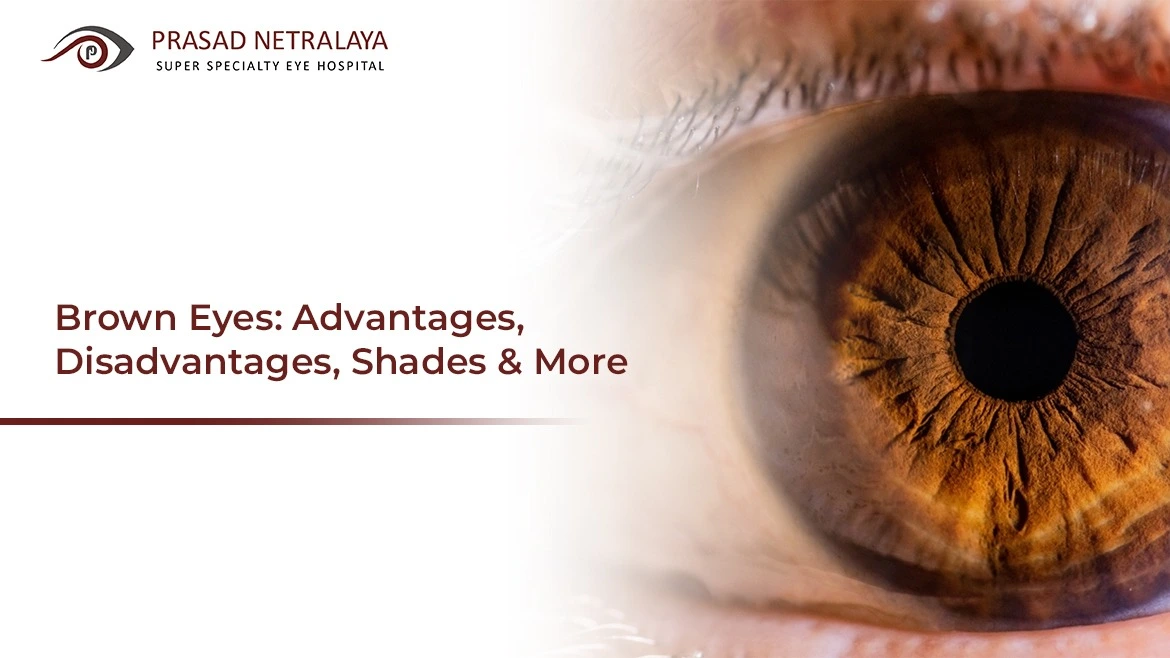Eye freckles or nevus (Plural: Nevi) are the brown spots found in the white portion (sclera) or iris (coloured part) of the eye. The brown spots in the eyes are mostly harmless. In rare cases, these eye freckles tend to grow or change shape. This is a sign that the spots might be a case of melanoma, a type of cancer.
In this comprehensive blog, we will look into the causes of Brown Eyes (Brown spots in the eyes), its effects, advantages, and disadvantages.
Table of Contents
What Causes Brown Eyes?
Brown eyes, or to be precise, the brown spots in the eyes form due to the clumping of pigment cells called melanocytes. Some people have these spots since birth, while others see their development with age.
Usually, melanocytes spread evenly throughout our body tissues. These are the cells responsible for providing pigmentation to our skin, hair, and eyes. When some of these cells clump at a place, they cause freckles, moles, and light or dark brown eye spots.
According to the American Academy of Ophthalmology, overexposure to UV lights causes eye dark spots.
What Are the Advantages of Brown Spots in the Eyes?
Practically, there is no advantage or benefit associated with brown spots in the eyes. They are eye freckles and have nothing to do with the iris pigmentation.
Studies depict that light-coloured eyes such as blue, grey, and green are at higher risk of developing ocular melanoma. In contrast, brown-coloured eyeballs offer specific benefits and protection against some eye diseases due to their high levels of melanin.
What Are the Disadvantages of Brown Spots in the Eyes?
Brown spots in the eyes are harmless, but they are a matter of concern in some cases. The most common type of eye cancer is Ocular Melanoma, which develops in melanocytes.
Melanoma appears with very few early warning signs. Many people get diagnosed with the disease only when the cancer reaches the advanced stage. The exact reason behind the condition’s occurrence is unknown, but experts believe that multiple health and environmental factors play a crucial role in its emergence.
What Are the Effects of Brown Spots in the Eyes and Iris?
The occurrence of melanoma is sporadic and uncommon. Statistically, only five out of every one million adults are diagnosed with this condition. The medical realm has examined and detected the following symptoms associated with ocular melanoma:
- Sudden Loss of vision
- Floaters of light
- Blurry vision
- Brown spots in the eye white or iris that keep getting bigger
- Change is the shape or size of the pupil
- Change is the movement of the eyeball
- Bulging of eye
Do Shades of the Eye Cause Brown Spots or Melanoma?
The amount of melanin our body creates determines the colour of our eyes. On the other hand, brown spots in the eyes mean that melanocytes are grouping or clumping. The brown eyes and brown spots differ, except that melanocytes play a vital role in their formation.
Melanoma, a type of eye cancer, occurs in the melanocytes cells. The following are the underlying risk factors related to Melanoma:
- Age: The risk of ocular melanoma, which can affect the iris, the choroid layer, or the ciliary body, increases as the person ages.
- Light eye colour: People with lighter eye pigmentation have a greater chance of melanoma than those with darker colours.
- Being White: White people tend to have less melanin in their body, hence regulating their risk to melanin comparatively lower to other races.
- Inherited disorders: Certain hereditary skin disorders, such as Dysplastic Nevus, create abnormal moles, further increasing the risk of developing melanoma.
- UV Light exposure: The role of UV rays light still needs to be completely clear. However, some indicate that excessive exposure to ultraviolet rays increases the risk of melanoma.
Decoding Brown Eyes: Advantages, Challenges, Hues, and Insights into Vision
Exploring the world of brown eyes has shown us various advantages, disadvantages, and shades. Interestingly, having an eye freckle is quite common, with around 50% of people being born with or developing one. Getting it checked by an ophthalmologist to understand your spots better is still a good idea.
Visit Prasad Netralaya Eye Hospital to book an appointment and get the brown spots examined by the specialized ophthalmologists’ medical team.
Read more: Unraveling the Causes of Blurry Vision During Pregnancy



